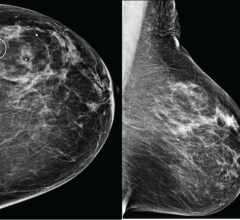
Davenport assessing an image with another health care professional. Credit: Michigan Medicine
July 5, 2022 — In April 2022, a shutdown of Shanghai due to China’s “zero COVID” policy caused a global shortage of iodinated contrast media produced by GE Healthcare. Many health systems, roughly half the market share in the United States, use GE Healthcare as their preferred vendor for contrast media, and GE Healthcare has most of its contrast media manufacturing centered in Shanghai.
Contrast media is used to improve diagnostic imaging, and the shortage has affected millions of examinations. More than 50 million diagnostic imaging examinations using contrast media are conducted annually, including nearly all angiography and approximately half of all CT scans. Contrast media is necessary for some types of exams, such as evaluation of the heart arteries and CT for acute bleeding, and improves diagnostic accuracy for others, like CT for cancer or infection.
GE Healthcare has been increasing production at its Shanghai facility, has increased production at its facility in Ireland and has been airlifting contrast media to the United States. It’s estimated that production should be normalized by the end of June 2022. However, China is still pursuing a zero-COVID policy, so the future remains unpredictable, says Matthew Davenport, M.D., a radiologist at University of Michigan Health and vice chair of the commission on quality and safety for the American College of Radiology.
“During this acute shortage, health systems have been forced to compare their stock-on-hand with the anticipated return-to-normal date to determine how aggressively to conserve contrast material,” Davenport said. “The goal has been to avoid running out, which would prevent imaging of patients for whom contrast media was necessary, and to conserve contrast media in a way that is safest for patients.”
In a recent letter published in JAMA, Davenport and a team of researchers modeled several ways to conserve contrast media. They found that a combination of methods could reduce contrast media use for CT scans by approximately 80% if a moderate reduction in diagnostic accuracy could be tolerated:
Weight-based dosing and changing CT settings
In the analysis, researchers examined what would happen if a system switched from fixed doses of contrast media to selecting the dose of contrast media based on the weight of each individual patient.
The team found that for a model of 1 million CT scans, moving to weight-based dosing could reduce contrast media use by 12%.
The second method they examined was changing the settings on the CT scanner, allowing the machine to better detect smaller amounts of contrast media. This adjustment, Davenport notes, works best for smaller patients.
“This strategy does not work well for larger patients due to increased image noise,” he said. “But in smaller patients, those who weigh under 80 kilograms, the contrast media dose can be reduced by up to 40%.”
Unenhanced CT: CT without contrast material
If you are performing a coronary angiogram to examine the arteries of the heart, or a CT scan to look for a possibly fatal aortic dissection, contrast media is required. Imaging of the blood vessels with CT scan or fluoroscopy tends to necessitate use of contrast media. Davenport likens this to using a flashlight in a dark room. Without the flashlight, nothing can be seen.
Some imaging can be done with “unenhanced CT,” without using contrast media. However, in many cases, this results in a loss of diagnostic accuracy. A correct diagnosis can often be made, but in some patients, it may be wrong or incomplete. Davenport compares this to the lights on an ambulance.
“You can probably still see the ambulance without the lights but having the lights on the ambulance makes it much more likely you will see it,” he said. “The lights and sirens on an ambulance make it easier to perceive. It’s similar with contrast media.”
Eliminating contrast media by using unenhanced CT conserves far and away the most contrast media (78%), but only if a moderate reduction in diagnostic accuracy can be tolerated.
Systemic changes needed
Most hospitals affected by the contrast media shortage have already made local decisions about how to preserve contrast media and reduce use. However, Davenport says, the shortage raises serious questions about supply chain risk. It will be important to minimize the chance of this happening in the future, Davenport says.
Most health systems purchase the majority of their contrast media through a single vendor, like GE Healthcare, to save money through preferred vendor contracting. Despite GE’s ramping up of contrast media production, a COVID-19 outbreak in China could hamper the supply chain once again.
“Whether this is originating in China with contrast media or in the United States with infant formula, supply chain redundancy is a critical lesson we are relearning the hard way,” Davenport said. “When health systems are making purchasing decisions, they should consider the robustness of the supply chain as one potential risk. Contrast media and infant formula are important for health and used daily. We need to minimize the risk of losing access to critical products. We can’t put too many eggs in too few baskets.”
Despite the challenges, Davenport says he respects the professionalism of the many health care providers managing the contrast media shortage.
“Nobody wants to be in this situation, but I have been continually impressed by the level of diligence and responsibility that has gone into troubleshooting this issue,” he said.
Additional authors include: Philip Chu, M.S., Rebecca Smith-Bindman, M.D., both of the Department of Epidemiology and Biostatistics, University of California, San Francisco, Timothy P. Szczykutowicz, Ph.D., Department of Radiology, University of Wisconsin, Madison.
Paper cited: “Comparison of Strategies to Conserve Iodinated Intravascular Contrast Media for Computed Tomography During a Shortage,” JAMA. DOI: 10.1001/jama.2022.987
For more information: https://med.umich.edu/
Related Content on Gadolinium Concerns
AJR Publishes Best Practices for Iodinated Contrast Media Shortage
Voluntary Dismissal of Chuck Norris Gadolinium Case Involving Bracco
VIDEO: How Serious is MRI Gadolinium Retention in the Brain and Body? An interview with Max Wintermark, M.D.
VIDEO “Big Concerns Remain for MRI Gadolinium Contrast Safety at RSNA 2017,” An interview with Emanuel Kanal, M.D.
Radiology Has Failed to Properly Assess or Track MRI Gadolinium Contrast Safety
Recent Developments in Contrast Media
FDA Committee Votes to Expand Warning Labels on Gadolinium-Based Contrast Agents
European Medicines Agency Issues Update on Gadolinium Contrast Agents


 December 03, 2025
December 03, 2025 









